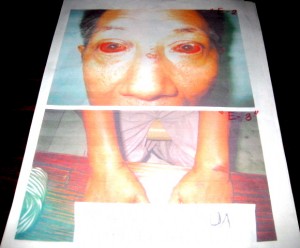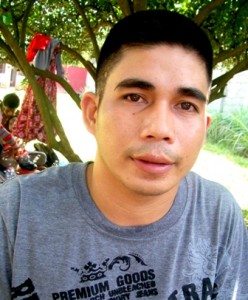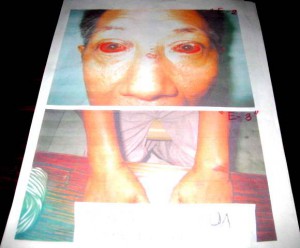By KENNETH GUDA and MYLAH REYES ROQUE

SOME members of the Philippine National Police and the Armed Forces of the Philippines are like Roman soldiers subjecting people to the same Calvary—arrest and torture—that Christ went through two millennia ago.
Muhammadiya Hamja, a fisherman, has been languishing in jail since 2008, still suffering the effects of severe torture in the hands of elements of the PNP Criminal Investigation and Detention Group (CIDG). He often has a hard time sleeping. His urine is tinged with blood.
Patta Jahal Hoyo was quietly going about his work as tricycle driver when he was accosted, interrogated and thrown into jail, where he has been since last November.
Margie Evangelista has been searching for her husband Darius, who has been missing since March last year. He is believed to be the man shown being tortured by a Manila policeman in a video shown on national television last year. Margie filed the first ever case that will test the new anti-torture law.
In November 2009, Congress passed Republic Act No. 9745, also known as the Anti-Torture Act. Yet law enforcers continue to use torture and are hardly ever punished for doing so.
“Most individuals ending up as torture victims were the ones initially arrested without warrant or merely ‘invited’ for questioning and taken to detention centers, safe houses and military camps,” said Edeliza Hernandez, executive director of the Medical Action Group that treats torture victims.
The heyday of torturers was the martial law era under Ferdinand Marcos. But the practice continued even after he was overthrown in the 1986 People Power Revolution.
Records of the Task Force Detainees show 3,171 cases of torture from 1982 to 1992, when Marcos’ successor, pro-democracy icon Corazon Aquino, stepped down from office.
During the nine-year term of former president Gloria Macapagal Arroyo, the numbers dropped to 179 recorded cases of torture involving 354 individuals. But human rights groups say the fact that torture continues shows the Philippine government’s failure to abide by the United Nations Convention Against Torture, which it signed and ratified in 1986.
Human rights groups say Hamja and Hoyo are innocent of the crimes they are being charged with: Kidnap for ransom in Mindanao more than 10 years ago. Despite evidence of their innocence, there is no sign they will be released soon.
A decade of calvary
Hamja is facing charges for the hostage-taking of 21 tourists in a resort in Sipadan, Malaysia near the Jolo island in April 2000 and the kidnapping of 15 employees of a Golden Harvest plantation in Lantawan, Basilan in June 2001.
He was among more than 150 individuals arbitrarily rounded up in Basilan after Arroyo declared a “state of lawlessness and rebellion” in the province in July 2001, said the Moro Christian People’s Alliance (MCPA), an organization helping in building solidarity between Christians and Muslims in Mindanao.
Hamja and several others were brought to Camp Bagong Diwa in Taguig City later that year. During that time, he claimed to have been tortured as well. “It was hard on us,” his son Ahmad recalled. “I had to relocate to Taguig to regularly visit him. It took its toll on our family.”
In June 2005, the Pasig Regional Trial Court ordered Hamja released after more than 60 witnesses produced by government prosecutors, including American citizen and former Abu Sayyaf kidnap victim Gracia Burnham, failed to identify him as a participant in any of series of kidnappings in 2000 and 2001.
After his release, Hamja and his family decided to stay in Manila for fear the military or the police would continue to harass him and accuse him of being a terrorist if he returned to Basilan. Little did he know that he would be hounded, even in Manila.
In November 2008, armed men arrested Hamja while he was praying in a Taguig mosque, blindfolded him and shoved him into a van. His family could not locate him.
“We looked everywhere. We looked for three days,” said Ahmad.
Ahmad sought the help of Commission on Human Rights and Karapatan, a human rights alliance. Together with Karapatan volunteers and CHR representatives, Ahmad knocked on the doors of Army and police camps, detachments and jails in Taguig and Pasig, hoping to find his father.
On the third day, Ahmad reached the CIDG Building in Camp Crame in Quezon City, where he finally found his father. “His face was swollen, his eyes were all red. He could hardly recognize me or anyone. He had bruises all over,” said Ahmad.
Hamja later told him about the torture. “He was repeatedly kicked, punched, slapped. His face was covered with plastic to prevent him from breathing,” Ahmad said.
Based on a complaint Ahmad filed, the CHR launched an investigation that led to the filing of contempt against Navy officers Antonio Habulan and Bayani Gaerlan, former commanders of the Naval Intelligence and Security Force. Both have ignored several inquiries into the enforced disappearance of Hamja since 2008, according to the CHR.
The CIDG men told Ahmad that his father was being charged with the kidnapping incidents in Sipadan and in Lantawan, the same cases he was not found guilty of.
This CIDG brought Hamja back to Basilan where he was jailed in December 2008. In February 2009, he was brought to the Basilan Regional Trial Court Branch 2, under Judge Danilo Bucoy, who immediately ordered his release because the case against him constituted “double jeopardy.”
But before Muhammadiya was to be released, the prosecutor filed another case against him, this time at the Basilan Regional Trial Court Branch 1, under Judge Leo Principe.
Before that court, the CIDG presented a “witness” who testified that the CIDG “requested him” to identify Muhammadiya as one of the kidnappers of the 21 tourists in Sipadan.
Since then, the court has not again heard Muhammadiya’s case.
Hoyo’s hardship

To his neighbors and friends in Barangay Culiat, Tandang Sora in Quezon City, Hoyo was just a tricycle driver. But to the PNP, he was a “terrorist,” a member of the dreaded Abu Sayyaf group based in Mindanao.
Hoyo was arrested at 10 a.m. on Nov. 3, 2010, in front of a subdivision in Tandang Sora. The next day, PNP spokesman Senior Supt. Agrimero Cruz Jr. announced to the media that they bagged Hoyo during an operation conducted by members of the Police Anti-Crime and Emergency Response (Pacer), 300th Air Force Intelligence Security Group and the Quezon City Police District.
The arrested man, Cruz said, “was involved in two different incidents of hostage-taking” and that he was previously known to the Abu Sayyaf as Abu Najer, one of those who accompanied Aldam Tilao, better known as Abu Sabaya, as he and the rest of the Abu Sayyaf once wreaked havoc in Basilan.
Hoyo denied being part of the bandit group. He said the supposed kidnapping incidents happened in 2001, when he was only 10 years old. He said he was then enrolled in a local high school in Lamitan. He was 21 when he was arrested.
“Tinanong nila kung saan daw ako noong 2001. Sabi ko nag-aaral ako (They asked me where I was in 2001. I said I was studying),” Hoyo said during an interview with human rights workers of the MCPA in Basilan City Jail, where he was brought and detained a week after his arrest in Quezon City.
Hoyo said he arrived in Manila in 2008, after leaving high school in Lamitan. He was in and out of various menial jobs for a couple of years while saving up to work abroad. But when the plan failed to materialize, Hoyo started working as a tricycle driver in the barangay known for its large Moro migrant population.
The day after his arrest, Hoyo’s wife Saida visited him, along with members of the Culiat Tricycle Operators and Drivers Association (TODA)—to testify before the authorities of Hoyo’s innocence.
“Hiningi pati ‘yung TODA namin, yung presidente, na palabasin ako kasi alam nila ang ugali dun, wala akong kasalanan. Kasama pati yung presidente ng TODA namin at saka dispatcher at bise presidente namin, pumunta sila dun sa Pacer (The TODA president knows I’m innocent and asked for my release. The TODA president, dispatcher and vice president went to Pacer),” Hoyo said.
But Hoyo remained in jail. He said he asked his captors to immediately bring him before a court, but his request was denied. Hoyo was then presented a warrant of arrest—of a certain Abu Najer, ordered by Judge Principe.
Hoyo said he stayed in the custody of Pacer for five days, before being brought to Zamboanga City on Nov. 8 on a Cebu Pacific flight, and then to Basilan. As of this writing, Hoyo still awaits a hearing on his case.
Missing
Margie Evangelista remembers that it was her own neighbors who called her attention to the video of the naked man who looked like her husband. The video was being shown on television as part of an expose on police brutality.
“Bago pa lumabas ang video, may kumalat ng balita sa lugar namin na may video nga daw ng torture ni Darius pero hindi ako naniwala. Hinahanap ko pa rin siya (Even before the video was shown, news was circulating that there was a video of Darius’ torture. But I didn’t believe the news and continued to look for him),” she said.
Margie rushed to the TV station the following day to have a longer look at the video. “Siya iyon, iyon ang mga tattoo nya (That’s him; that was his tattoo).”
The PNP immediately formed Task Force Asuncion, so named after the Police Community Precinct in Asuncion, Tondo, where the torture is reported to have occurred. Based on the task force report, the CIDG and NCR Criminal Investigation and Detection Unit filed an information for torture on Aug. 23, 2010 before the Department of Justice against Joselito Binayug, as well as his immediate superior, Supt. Ernesto V. Tendero Jr., and seven other colleagues: Supt. Rogelio T. Rosales, SPO3 Joaquin M. de Guzman, SPO1 Rodolfo S. Ong, SPO1 Burt N. Tupas, SPO1 Dante F. Bautista, PO1 Nonito B. Binayug and PO1 Rex C. Binayug.
The PNP based its case on the complaint filed by Margie, who earlier approached the CHR for help. Her claim was bolstered by her father-in-law, Asprin, as well as three men detained at police station 11 who testified they saw Darius at the station on March 5 looking battered, with his eyes and mouth covered by tape.
Renato A. Peralta, Emmanuel T. Miranda and Sonny H. Lim also stated in their affidavits that they heard Binayug order his men, “Itumba na yan (Eliminate him),” shortly before Darius was brought out of the station.
The three men also claimed Darius was the same man in the video because they are familiar with his tattoos. Apparently, Darius and the three others knew one another as petty crime offenders repeatedly jailed at the Manila City Jail and members of the Commando gang.
NCR Police Director Nicanor Bartolome ordered the dismissal of Binayug from service for violation of the anti-torture act amounting to grave misconduct.
But another family is claiming that the man in the video was not Darius but Vicente M. Orbigo, allegedly killed in an encounter with police led by Binayug on Aug. 13, five months after Darius went missing and about the same time that the torture video was aired.
ABS-CBN reported that the National Bureau of Investigation’s autopsy revealed Orbigo died from gunshot wounds, had tattoos on the body and his genitals had ligature marks. The NBI, however, said this was not conclusive that Orbigo was the man in the video.
(This story is part of the VERA Files project “Human Rights Case Watch” supported by The Asia Foundation and the UnitedStates Agency for International Development.)
